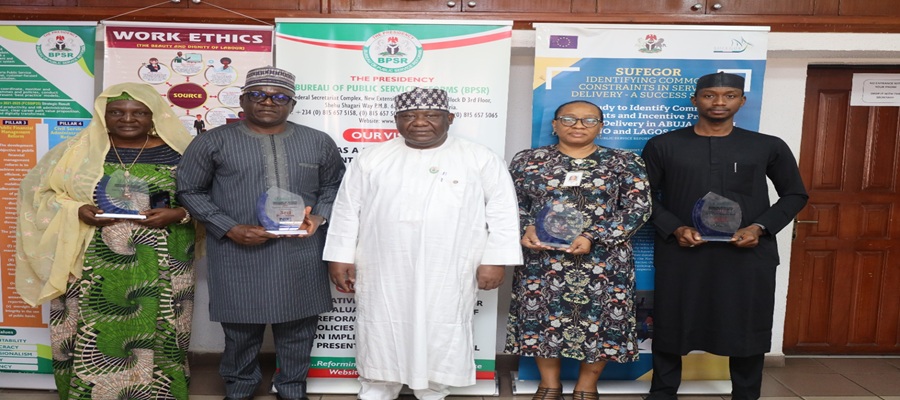Telecom
Cell Phones Causing Young People to Grow Horns on Skulls- Research

Researchers at the University of the Sunshine Coast in Queensland, Australia have found evidence that our frequent use of mobile devices could be causing horn-like bone spurs to appear on younger adults.
New research in biomechanics suggested that mobile phones are remolding human skeletons, possibly altering not just the behaviours but the bodies we inhabit.
According to the research, young people are developing hornlike spikes at the back of their skulls — bone spurs caused by the forward tilt of the head, which shifts weight from the spine to the muscles at the back of the head, causing bone growth in the connecting tendons and ligaments.
The weight transfer that causes the buildup can be compared to the way the skin thickens into a callus as a response to pressure or abrasion.
The result is a hook or hornlike feature jutting out from the skull, just above the neck.
In academic papers, a pair of researchers at the University of the Sunshine Coast in Queensland, Australia, argues that the prevalence of the bone growth in younger adults points to shifting body posture brought about by the use of modern technology.
They say smartphones and other handheld devices are contorting the human form, requiring users to bend their heads forward to make sense of what’s happening on the miniature screens.
The researchers said their discovery marks the first documentation of a physiological or skeletal adaptation to the penetration of advanced technology into everyday life.
Health experts warn of “text neck,” and doctors have begun treating “texting thumb,” which is not a clearly defined condition but bears resemblance to carpal tunnel syndrome. But prior research has not linked phone use to bone-deep changes in the body.
“An important question is what the future holds for the young adult populations in our study, when development of a degenerative process is evident in such an early stage of their lives?” ask the authors in their most recent paper, published in Nature Research’s peer-reviewed, open access Scientific Reports.
The study came out last year but has received fresh attention following the publication last week of a BBC story that considers, “How modern life is transforming the human skeleton.”
Since then, the unusual formations have captured the attention of Australian media, and have variously been dubbed “head horns” or “phone bones” or “spikes” or “weird bumps.”
Each is a fitting description, said David Shahar, the paper’s first author, a chiropractor who recently completed a PhD in biomechanics at Sunshine Coast.
“That is up to anyone’s imagination,” he told The Washington Post. “You may say it looks like a bird’s beak, a horn, a hook.”
However it is designated, said Shahar, the formation is a sign of a serious deformity in posture that can cause chronic headaches and pain in the upper back and neck.
Part of what was striking about their findings, he said, was the size of the bone spurs, which are thought to be large if they measure 3 or 5 millimeters in length. An outgrowth was only factored in to their research if it measured 10 millimeters, or about two-fifths of an inch.
The danger is not the head horn itself, said Mark Sayers, an associate professor of biomechanics at Sunshine Coast who served as Shahar’s supervisor and co-author. Rather, the formation is a “portent of something nasty going on elsewhere, a sign that the head and neck are not in the proper configuration,” he told The Washington Post.
Their work began about three years ago with a pile of neck X-rays taken in Queensland. The images captured part of the skull, including the area where the bony projections, called enthesophytes, form at the back of the head.
Contrary to conventional understanding of the hornlike structures, which have been thought to crop up rarely and mainly among older people suffering from prolonged strain, Shahar noticed that they appeared prominently on X-rays of younger subjects, including those who were showing no obvious symptoms.
The pair’s first paper, published in the Journal of Anatomy in 2016, enlisted a sample of 218 X-rays, of subjects ages 18 to 30, to suggest that the bone growth could be observed in 41 percent of young adults, much more than previously thought. The feature was more prevalent among men than among women.
The effect — known as enlarged external occipital protuberance — used to be so uncommon, Sayers said, that one of its early observers, toward the end of the 19th century, objected to its title, arguing that there was no real protrusion.
That’s no longer the case.
Another paper, published in Clinical Biomechanics in the spring of 2018, used a case study involving four teenagers to argue that the head horns were not caused by genetic factors or inflammation, pointing instead to the mechanical load on muscles in the skull and neck.
And the Scientific Reports paper, published the month before, zoomed out to consider a sample of 1,200 X-rays of subjects in Queensland, ages 18 to 86.
The researchers found that the size of the bone growth, present in 33 percent of the population, actually decreased with age. That discovery was in stark contrast to existing scientific understanding, which had long held that the slow, degenerative process occurred with aging.
They found instead that the bone spurs were larger and more common among young people. To understand what was driving the effect, they looked to recent developments — circumstances over the last 10 or 20 years altering how young people hold their bodies.
“These formations take a long time to develop, so that means that those individuals who suffer from them probably have been stressing that area since early childhood,” Shahar explained.
The sort of strain required for bone to infiltrate the tendon pointed him to handheld devices that bring the head forward and down, requiring the use of muscles at the back of the skull to prevent the head from falling to the chest. “What happens with technology?” he said.
“People are more sedentary; they put their head forward, to look at their devices. That requires an adaptive process to spread the load.”
That the bone growth develops over a long period of time suggests that sustained improvement in posture can stop it short and even ward off its associated effects.
The answer is not necessarily swearing off technology, Sayers said. At least, there are less drastic interventions.
“What we need are coping mechanisms that reflect how important technology has become in our lives,” he said.
Shahar is pressing people to become as regimented about posture as they became about dental hygiene in the 1970s, when personal care came to involve brushing and flossing every day. Schools should teach simple posture strategies, he said. Everyone who uses technology during the day should get used to recalibrating their posture at night.
As motivation, he suggested reaching a hand around to the lower rear of the skull. Those who have the hornlike feature can likely feel it.
Telecom
NCC Ranked Among Top 3 MDAs for Best Website Performance in 2025

Bureau of Public Service Reforms (BPSR) has named the Nigerian Communications Commission (NCC) among the top three Ministries, Departments and Agencies (MDAs) of the Federal Government with the Best Ranking in Website Performance for 2025.

L-R: Head Special Projects, Nigerian Export Promotion Council (NEPC), Salamatu Andu; Executive Commissioner, Technical Services, Nigerian Communication Commission (NCC), Engr. Abaraham Oshadame; Director General Bureau of Public Service Reforms (BPSR), Head Customer Support Service, Galaxy Backbone, Rosemary Ehize; Secretary to the ES. Nigerian Content Development and Monitoring Board, Tahir Aminu at the BPSR award ceremony for top four MDAs in BPSR Website Performance and Ranking 2025 at the BPSR office on Tuesday, 23rd December, 2025.
This is coming barely three weeks after the telecom regulator was recognized as one of the top five best-performing Federal Government agencies for 2025 by the Presidential Enabling Business Environment Council (PEBEC) – a testament to the Commission’s consistency in investment in technology for ensuring efficient service delivery.
In the BPSR 2024/2025 scorecard ranking of agencies’ websites, the NCC came second in the ranking, trailing behind Galaxy Backbone Limited, which came first while the Nigeria Export Promotion Council (NEPC) clinched the third position, from a pool of 235 MDAs, whose website were evaluated.
BPSR deployed 14 evaluation criteria in include MDA’s website compliance with .gov.ng domain name, appearance and aesthetics (look and feel) of the website, content, relevance to MDAs mandate/government policy and the website’ structure.
Others include website’s responsiveness (device compatibility), security, load time, usability/ease of navigation, availability/uptime, functionality, interactivity, accessibility and capacity building.
The recognition was announced at the official release of Federal Government 2024/2025 Scorecard Ranking for MDAs’ Website held at the Federal Ministry of Finance Auditorium in Abuja on Monday (December 22, 2025) while the award presentation took place at BPSR’s Office on Tuesday (December 23, 2025).
The award, which is an important index metric of the National e-Government Masterplan for determining the Nigeria e-Government Status, was received by the Commission in recognition of its commitment to maintaining a world-class website that enhances service delivery to the citizens.
Receiving the award on behalf of the Executive Vice Chairman of the NCC, Dr. Aminu Maida, the NCC’s Executive Commissioner, Technical Services, Abraham Oshadami, appreciated the BPSR for the recognition, describing the award as “another encouragement for the Commission to be a better public service institution leveraging digital platforms such as our web presence to enhance public service delivery to our various stakeholders, thereby implementing the Federal Government’s Ease of Doing Business policy direction.”
While presenting the award to the NCC, alongside other two agencies, BPSR’s Director-General, Mr. Dasuki Arabi, commended the top three for their proactive decisions in maintaining world-class websites, which are compliant with the Federal Government’s policy direction in effective and efficient service delivery to the citizens.
According to the DG, the 2024/2025 MDA’s websites’ ranking represents a collective effort of federal public institutions in Nigeria to be transparent, accountable and open in governance, as well as a confirmation to align with global best practices in service delivery to the citizens.
Developed about six years ago, Arabi said as a result of the annual ranking, more public institutions have indicated readiness to embrace reforms, and align with the policy direction of the current administration’s Renewed Hope agenda on improve governance for effective service delivery, as introduced by His Excellency President Bola Ahmed Tinubu.
“The ideals of harnessing and deploying technological tools for service delivery has become imperative following the COVID pandemic, and distortions of socio-economic system of nations, culminating in the evolution of competitiveness, cost effectiveness, and agile governance.
“As engine room of governance, it behoves on us in the public service to perform our statutory duties and we must put in place technological innovations and standardized websites to operate services as well as deliver service needs to citizens,” he said.
The Scorecard exercise, he said, is part of the BPSR reform broader function of conducting research on reform implementation efforts and presenting ‘best practice’ models to the entire Public Service, and to among others, improve access to government information, facilitate seamless financial transaction, eliminate corruption and cyber theft, as well as facilitate access to government services.
Speaking on the rigorous nature of the exercise that produced the top three winners, the DG said “in the past few weeks members of the Scorecard Jury drawn from inter-Ministerial Agencies, had worked tirelessly to mill websites of selected MDAs through a rigorous process of enduring criteria for the ranking and the outcome had also passed through a quality assurance mechanism to validate the outcome.”
Telecom
Oyedele Dismisses Claims Bank Accounts Without TIN Will Be Frozen

Taiwo Oyedele, Chairman of the Presidential Committee on Fiscal Policy and Tax Reforms, has dismissed reports that bank accounts not linked to a Tax Identification Number (TIN) will be frozen or automatically debited from January 1, 2026.

Taiwo Oyedele
Oyedele described the claims as false and misleading, warning Nigerians against panic over misinformation surrounding recent tax and financial reforms.
In a post on his X handle Tuesday morning, he wrote: “Don’t let anyone manipulate you. Your bank account is safe. Misinformation makes you panic and fear a reform that is designed to help you.
“When they tell you that your account will be frozen or automatically debited from January 2026, ask them for the evidence in the new law. Be wise.”
He stressed that no provision in the new tax laws authorises the freezing of bank accounts, adding that the rumours are part of widespread misrepresentation of the reforms.
The committee chairman reiterated that the reforms are intended to simplify Nigeria’s tax system and ease the burden on ordinary citizens, not to impose punitive measures on bank customers.
Telecom
Amazon Blocks 1,800 North Koreans From Job Applications

US tech giant, Amazon has disclosed that it blocked more than 1,800 North Koreans from applying for jobs, amid growing concerns that Pyongyang is deploying large numbers of IT workers overseas to earn and launder funds.

Amazon
In a LinkedIn post, Amazon’s Chief Security Officer, Stephen Schmidt, said North Korean nationals have been attempting to secure remote IT roles with companies around the world, particularly in the United States.
He noted that the company recorded nearly a one-third increase in such applications over the past year.
According to Schmidt, many of the applicants operate through so-called “laptop farms” — computers physically located in the US but remotely controlled from abroad.
He warned that the issue is not unique to Amazon and is likely occurring at scale across the tech industry.
He added that common red flags include incorrectly formatted phone numbers and questionable academic credentials.
The issue has previously drawn the attention of US authorities. In July, a woman in Arizona was sentenced to more than eight years in prison for running a laptop farm that helped North Korean IT workers obtain remote jobs at more than 300 US companies.
Officials said the scheme generated over $17 million in revenue for both the woman and North Korea.
Last year, South Korea’s intelligence agency also warned that North Korean operatives were using LinkedIn to pose as recruiters, approaching South Koreans working at defence companies in an attempt to steal sensitive technological information.
“North Korea is actively training cyber personnel and infiltrating key locations worldwide,” Hong Min, an analyst at the Korea Institute for National Unification, told AFP.
He added that, given Amazon’s business model, the motivation behind such operations is largely economic, with a high likelihood of attempts to steal financial assets.
North Korea’s cyber warfare programme dates back to at least the mid-1990s and has since expanded into a cyber unit of about 6,000 personnel known as Bureau 121, according to a 2020 US military report.
In November, Washington announced sanctions against eight individuals accused of being state-sponsored hackers, alleging their illicit activities were carried out to fund North Korea’s nuclear weapons programme.
The US Treasury has also accused North Korea-linked cybercriminals of stealing more than $3 billion over the past three years, primarily through cryptocurrency-related crimes.

 News2 days ago
News2 days agoUS Begins Partial Visa Ban on Nigerians January 1

 News2 days ago
News2 days agoDPLAN Threatens NDPC with Legal Action for Setting aside $32.8m Meta Fine

 News2 days ago
News2 days agoGlo Extends Christmas Greetings, Urges Unity and Care for Others

 E-Financial2 days ago
E-Financial2 days agoNOVA Bank Opens Regional Office in Owerri

 E-Financial2 days ago
E-Financial2 days agoNaira Stability, Lower Borrowing Costs Expected in 2026 — CBN Survey

 E-Financial1 day ago
E-Financial1 day agoFIRS says NIN, CAC Numbers to Serve as Tax IDs from 2026

 E-Business2 days ago
E-Business2 days agoGalaxy Backbone Tops FG’s Website Performance Ranking

 General News2 days ago
General News2 days agoBanks warn customers against public Wi-Fi for banking amid festive fraud surge




















